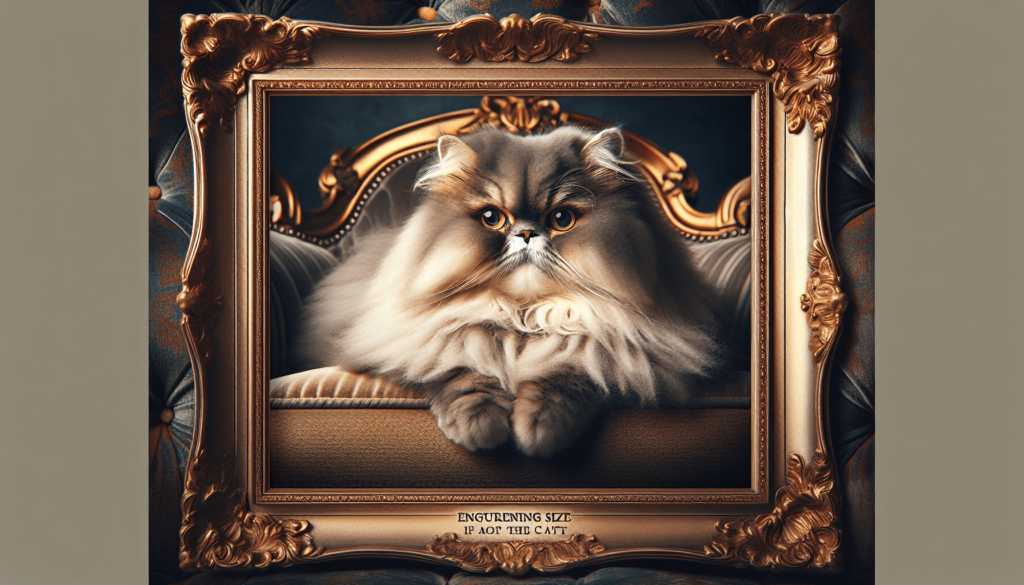Persian cats, known for their luxurious long fur and striking appearance, are a popular breed among cat lovers around the world. If you’ve ever wondered just how big these feline friends can grow, you’re in the right place. In this article, we’ll explore the size potential of Persian cats, giving you a glimpse into their adult dimensions and shedding light on the factors that can influence their growth. So if you’re ready to discover the impressive proportions of these majestic creatures, read on!

Average Size of Persian Cats
Persian cats are known for their luxurious coats and distinct facial features, but what about their size? As a pet owner, it’s helpful to have an understanding of the average size of Persian cats, both male and female.
Male Persian Cats
On average, adult male Persian cats weigh between 9 to 14 pounds (4 to 6.3 kilograms). However, it’s important to note that individual cats can vary in size, and some males may be larger or smaller than this range. Despite their relatively small size, male Persian cats have a sturdy build and a muscular physique.
Female Persian Cats
Female Persian cats, on the other hand, generally weigh between 7 to 12 pounds (3.2 to 5.4 kilograms) when fully grown. They are typically smaller than males but still maintain the signature Persian cat appearance with a plush coat and round face.
Adult Weight of Persian Cats
When considering the potential size of a Persian cat, it’s essential to understand how their weight can vary between males and females.
Male Persian Cats
As mentioned earlier, male Persian cats typically weigh between 9 to 14 pounds (4 to 6.3 kilograms) as adults. However, it’s not uncommon for some males to reach weights of up to 20 pounds (9 kilograms) or more. These larger Persians are often referred to as “giant” Persians and are the exception rather than the rule.
Female Persian Cats
Female Persian cats generally weigh between 7 to 12 pounds (3.2 to 5.4 kilograms) when fully grown. Like their male counterparts, there are cases where some females may exceed this weight range. However, it is less common for females to reach the same size as the giant males.
Growth and Development
Understanding the growth and development stages of Persian cats can provide insight into their eventual size.
Kitten Development
When Persian kittens are born, they are incredibly tiny and fragile. They rely entirely on their mother for nourishment and warmth. Over the first few weeks, they start developing their sense of sight, hearing, and coordination. During this stage, their growth is rapid, and they will quickly gain weight and size.
Adolescent Growth
As Persian kittens continue to grow, they enter their adolescent stage. This is when their bodies start to develop and change the most. They become more active and playful, running, jumping, and exploring their surroundings. It’s during this time that the foundation for their adult size is established.
Adult Size
By the time Persian cats reach adulthood, usually around 1 to 2 years old, their growth rate begins to slow down significantly. While they may still fill out and gain some weight, their overall size is mostly established at this point.
Factors Affecting Size
Several factors can influence the size of Persian cats. Let’s take a look at some of these factors:
Genetics
Genetics play a significant role in determining the size of Persian cats. The genes inherited from their parents influence their growth potential. If both parents are large, it’s highly likely that their offspring will be bigger as well. However, it’s important to remember that genetics are not the sole determinant of size, as other factors come into play.
Nutrition
Proper nutrition is vital for the healthy growth and development of Persian cats. Providing a balanced and nutritious diet tailored to their specific needs is crucial. Feeding them high-quality cat food that supports their overall health and meets their nutritional requirements can help them reach their full size potential.
Exercise
Regular exercise is important for maintaining a healthy weight and muscle tone in Persian cats. It helps prevent obesity and ensures that their bodies remain strong and agile. Engaging in playtime activities and providing them with interactive toys can help keep them active and physically fit.
Health
A cat’s overall health can also impact its size. Conditions such as malnutrition or underlying health issues can hinder growth and cause stunted development. Regular veterinary check-ups and prompt medical attention when needed are essential to ensure optimal health and size for Persian cats.

Largest Persian Cats on Record
While most Persian cats fall within the average size range, there have been some notable exceptions who have earned a place in history due to their extraordinary size.
Historical Examples
Throughout history, there have been records of Persian cats that have reached impressive sizes. Tales of massive male Persians weighing over 25 pounds (11.3 kilograms) have been documented. These oversized Persians have become legendary for their remarkable stature and have left an indelible mark on the breed’s history.
Famous Persian Cats
In recent times, there have been famous Persian cats who have gained attention for their significant size. These cats often have a social media presence and captivate audiences with their adorable and larger-than-life appearance. These famous cats serve as a testament to the varying sizes that Persian cats can achieve.
Comparison to Other Breeds
To better understand the size of Persian cats, it’s helpful to compare them to other popular cat breeds.
Persian vs. Maine Coon
Maine Coon cats are known for their large size, often overshadowing Persian cats in terms of sheer magnitude. While both breeds can reach impressive sizes, the Maine Coon typically outweighs the Persian, with the former regularly exceeding 20 pounds (9 kilograms).
Persian vs. Ragdoll
Ragdoll cats are another breed that can rival the Persian in size. Both breeds have a similar weight range, with Ragdolls sometimes surpassing the Persian in size. Despite their size similarities, Ragdolls have a more athletic build compared to the stockier Persian.
Persian vs. British Shorthair
When comparing the Persian to the British Shorthair, the latter tends to be larger in size. British Shorthairs are known for their solid and robust bodies, often weighing more than Persians. The British Shorthair’s size can range from 12 to 18 pounds (5.4 to 8.2 kilograms), making it a substantial breed in terms of weight.
Size Expectations as a Pet Owner
As a prospective owner of a Persian cat, understanding their potential size is crucial in providing them with appropriate care and accommodations.
Understanding the Potential Size
Knowing the average size range for Persian cats can help set realistic expectations. While most Persians fall within the typical weight range, it’s essential to remember that individual cats can vary. Keeping an open mind and being prepared for a range of sizes can help ensure a positive experience as a pet owner.
Accommodating for Space
Due to their plush coats and potential for larger sizes, Persian cats require ample space to move around comfortably. Providing them with enough room to roam and stretch their legs is essential. Ensuring they have access to engaging toys and scratching posts can also help them stay active and prevent boredom.
Grooming Considerations
Persian cats are famous for their long, luxurious coats, but this beautiful feature requires regular grooming to keep it in top condition. As a pet owner, you must be prepared to commit to regular brushing sessions to prevent matting and keep their coats tangle-free. Additionally, occasional professional grooming may be necessary to maintain their stunning appearance.
Common Misconceptions
There are a few misconceptions surrounding the size of Persian cats that are important to address.
Persian Cats as Miniatures
Some people may assume that Persian cats are smaller in size, akin to miniature breeds. However, while Persian cats may exhibit smaller sizes compared to other large breeds, they are not considered miniatures. These cats can still grow to a substantial size, especially if genetics and other factors support it.
Perception vs. Reality
Perceptions about the size of Persian cats can often be influenced by media portrayals or the representations of certain individuals. It’s essential to separate perception from reality and understand that variations in size can exist within the breed. Each Persian cat is unique, and their size should be appreciated for its individuality.
Caring for Large Persian Cats
If you find yourself caring for a larger-than-average Persian cat, there are a few additional considerations to keep in mind.
Proper Nutrition
Providing a balanced and nutritious diet is crucial for all Persian cats, but it becomes even more important for larger individuals. Make sure to choose high-quality cat food that supports their specific needs and maintain portion control to prevent excessive weight gain.
Regular Veterinary Check-ups
Routine veterinary check-ups are essential to monitor the health and well-being of your Persian cat, regardless of their size. These visits allow for early detection and prevention of potential health issues, ensuring that your cat remains healthy and happy.
Exercise and Play
Engaging your Persian cat in regular exercise and play sessions is important, especially for larger cats. Providing them with opportunities to climb, explore, and engage in interactive activities can help keep them physically and mentally stimulated.
Grooming Needs
Larger Persian cats often have more substantial coats that require increased grooming attention. Regular brushing is essential to remove loose hair and prevent matting. If the coat becomes too challenging to manage, seek professional grooming assistance to ensure your cat’s comfort.
Conclusion
Persian cats are known for their beauty and charm, often captivating cat lovers worldwide. While their size can vary, understanding the average size range, potential factors that influence their growth, and comparisons to other breeds can help provide realistic expectations as a pet owner. Regardless of size, proper care, nutrition, and regular veterinary check-ups are crucial for the health and well-being of Persian cats. With the right knowledge and care, you can provide a comfortable and fulfilling life for your Persian cat, no matter its size.

